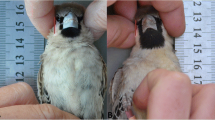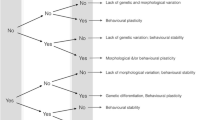Abstract
The anemone Phymactis clematis exhibits intraspecific agression. An investigation into dominance relationships amongst the 3 colour morphs collected from Vĩna del Mar, Chile, during June, 1980, revealed them to be equally aggressive. The outcomes of experimental contests appeared to reside solely with size-dependent differences in the threshold for the release of agression. Contests were asymmetric and larger individuals displayed aggression earlier against smaller opponents, and won encounters. An analysis of times for the onset of aggression in contests showed that they were highly variable and were not a good indicator of the absolute aggressive ability of individuals as denoted by dominance rankings. It provided, however, evidence indicating a lack of assessment of opponent size during initial contact. This is discussed in relation to the evolution of aggression in anemones and to the concept of evolutionarily stable strategies in contest behaviour. It is concluded that future work on the apparent size-dependent threshold will most instructively be conducted at the neurophysiological level.
Similar content being viewed by others
Literature cited
Äbel, E. F.: Ein Beitrag zur Giftwirkung der Actinien und Funktion der Randsäckchen. Zool. Anz. 153, 259–268 (1954)
Barnard, C. J. and T. Burk: Dominance hierarchies and the evolution of “individual recognition”. J. theor. Biol. 81, 65–73 (1979)
Bigger, C. H.: The acrorhagial response of Anthopleura krebsi: intraspecific and interspecific recognition. In: Coelenterate ecology and behaviour, pp 127–136. Ed. by G. O. Mackie. New York: Plenum Press 1976
Bigger, C. H.: Interspecific and intraspecific acrorhagial aggression among sea anemones: a recognition of self and not self. Biol. Bull. mar. biol. Lab., Woods Hole 159, 117–134 (1980)
Bonnin, J. P.: Recherches sur la ‘réaction d'aggression’ et sur le fonctionnement des acrorrhages d'Actinia equina L. Bull. biol. Fr. Belg. 1, 225–250 (1964)
Brace, R. C. and J. Pavey: Size-dependent dominance hierarchy in the anemone Actinia equina. Nature, Lond. 273, 752–753 (1978)
Brace, R. C., J. Pavey and D. L. J. Quicke.: Intraspecific aggression in the colour morphs of the anemone Actinia equina: the “convention” governing dominance ranking. Anim. Behav. 27, 553–561 (1979)
Calgren, O.: A survey of the Ptychodactaria, Corallimorpharia and Actinaria. K. svenska VtenskAkad. Handl. 1, 1–121 (1949)
Carter, D.: Actinias de Montemar, Valpariso. Revta Biol. mar. 12, 129–157 (1965)
Francis, L.: Clone specific segregation in the sea anemone Anthopleura elegantissima. Biol. Bull. mar. biol. Lab., Woods Hole 144, 64–72 (1973a)
Francis, L.: Intraspecific aggression and its effect on the distribution of Anthopleura elegantissima. Biol. Bull. mar. biol. Lab., Woods Hole 144, 73–92 (1973b)
Francis, L.: Social organisation within clones of the sea anemone Anthopleura elegantissima. Biol. Bull. mar. biol. Lab., Woods Hole 150, 361–376 (1976)
Hildemann, W. H., R. L. Raison, G. Cheung, C. J. Hull, L. Akaka, and J. Okamota: Immunological specificity and memory in a scleractinian coral. Nature, Lond. 270, 219–223 (1977)
Hines, W. G. S.: Competition with an evolutionary stable strategy. J. theor. Biol. 67, 141–153 (1977)
Grafen, A.: The hawk-dove game played between relatives. Anim. Behav. 27, 905–907 (1979)
Maynard Smith, J.: Game theory and the evolution of behaviour. Proc. R. Soc. (Ser. B) 205, 475–488 (1979)
Maynard Smith, J. and G. A. Parker: The logic of asymmetric contests. Anim. Behav. 24, 159–175 (1976)
Maynard Smith, J. and G. R. Price: The logic of animal conflicts. Nature, Lond. 246, 15–18 (1973)
McFarlane, I. D.: Two slow conduction systems in the sea anemone Calliactis parasitica. J. exp. Biol. 51, 377–385 (1969)
McFarlane, I. D.: Two slow conduction systems co-ordinate shell-climbing behaviour in the sea anemone Calliactis parasitica. J. exp. Biol. 64, 431–445 (1976)
Ottaway, J. R.: Ecology of the intertidal anemone Actinia tenebrosa I. Pedal locomotion and intraspecific aggression. Aust. J. mar. Freshwat. Res. 29, 787–802 (1978)
Shelton, G. A. B.: The transmission of impulses in the ectodermal slow conduction system of the sea anemone Calliactis parasitica. J. exp. Biol. 62, 421–432 (1975)
Author information
Authors and Affiliations
Additional information
Communicated by J. Mauchline, Oban
Rights and permissions
About this article
Cite this article
Brace, R.C. Intraspecific aggression in the colour morphs of the anemone Phymactis clematis from Chile. Marine Biology 64, 85–93 (1981). https://doi.org/10.1007/BF00394084
Accepted:
Issue Date:
DOI: https://doi.org/10.1007/BF00394084




